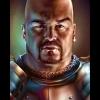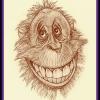Metal ore can be found in nature, but not the kind of nature druids represent (which is usually more woodlands and forests). And swords go a long way from nature.Druids might get some additional penalty, but I don't see why they shouldn't use their powers (metal can be found in nature too..in raw form, but still..)

Weapon Restrictions?
#21

Posted 29 July 2004 - 04:37 AM
#22

Posted 29 July 2004 - 06:17 AM
Since two-handers are really crippled (they should be doing AT LEAST 2D6 damage or more),I would gladly make them stronger, but thievs and mages get penalized if they carry them (Spellcasting speed reduced by.. 4, and thieving skills reduced by 50%)
I did not think of this kind of penalty, but this one : if a mage of level 15, for instance, equips a two-handed sword, he should have a THAC0 of 30, instead of the normal 17 (when wielding a dagger or a staff). As for spellcasting speed, I don't understand why it should be reduced. Well, we could suppose the fact that a mage needs his hands while casting a spell, but wielding a staff (which also requires 2 hands to wield it) does not affect spellcasting speed.
#23

Posted 29 July 2004 - 06:22 AM
Edited by NiGHTMARE, 29 July 2004 - 06:25 AM.
#24

Posted 29 July 2004 - 06:55 AM
Well, Bob, Gandalf is not a good example for that because he is not a wizard (at least in the way that ADD imagines the wizards), but a Maia. In ADD, he could have an equivalent only in the solars, planetars or devas, in my opinion.
Glamdring a magical sword, glows in the presence of an enemy and serves Gandalf in his mission to aid the Fellowship of the ring.

#25

Posted 29 July 2004 - 12:19 PM
Why can't I pick up somehing and swing it if I'm stong enough to do it?
Regardless if it's a sword, axe, staff, chair or espresso machine?
It makes no sense that a mage wiht no proficiency in a two-hander would have a smller THAC0 than a unproficient fighter. (aside the fact that the fighters do allready have a higher THAC0 on start which is fine)
In other words - mages should get no additional to hit penalty just becoause they are mages. Just carrying the big sword is penalty enough (heavy, they suck at it, slower spellcasting)
Now, it looks like most people agree that weapon restriction just don't kane sense.
The only thing that remains to be solved is how to handle Clerics/Druids and how mucth to penalyze Mages/Thiefs
- Vision of Escaflowne fan
- Modeler and modder
#26

Posted 29 July 2004 - 06:59 PM
Second of all, they still take the penalty for being non-proficient, as wizards may not take proficiencies in two-handed swords. If he has 14 strength, what other penalty do you need?
#27

Posted 30 July 2004 - 03:25 AM
Well, I agree that no other panalty is needed (simply sacrificing attribute points to STR makes you a weaker mage/thief ), but I'm not sure what other will think.
- Vision of Escaflowne fan
- Modeler and modder
#28

Posted 30 July 2004 - 05:23 AM
#29

Posted 30 July 2004 - 05:36 AM
Edited by NiGHTMARE, 30 July 2004 - 05:38 AM.
#30

Posted 31 July 2004 - 02:25 AM
You're thinking of the arthimetic mean, which is "the value obtained by calculating the sum of a set of quantities and then dividing that sum by the number of quantities in the set". So in this instance, take the strength of all humans in existence (lets say 1 trillion), add it all together, and then divide it by the number of humans in existence (the aforementioned 1 trillion).
The average I'm using is the mode, which is "the number or range of numbers in a set that occurs the most frequently". In other words, I'm talking about the most common amount of strength.
While arthimetic mean would require there to be as many people with a strength below 10 as there are with a strength above 10, mode has no such requirement. There could be tens of thousands of people with a strength of 11-25 and only a few hundred people with a strength of 1-9, but neither would have any influence on the fact that there are hundreds of millions of people with a strength of 10, and hence 10 is the average.
Edited by NiGHTMARE, 31 July 2004 - 02:27 AM.
#31

Posted 31 July 2004 - 04:38 AM
That is true, but people allway re-rol to get higher stats.9 - 10 is the average because it is the average you will get from rolling 3d6 . This is true of ALL stats, not just Strength. 9 intelligence, say, means you've been around in the world a bit, maybe even gone to School. 10 intelligence means you've been to Uni, done high courses. 11 - 12 is the equivalent of atleast a PHD, probably a fair bit of experience in the field aswell. 13 - 15 is Einstein, Newton, Archimedes. So, that gnomish Mage with 19 int isn't just 'above average', but can recite any verse from the Bible, the Encylopedia Britanica, and KA Applegate's Animorphs, in every language in existance, without so much asthinking about it.
And that Sorcerer or Kensai with 4 -5 int, would have trouble telling someone their name.
The same principal applies to Strength. 9 - 10 Strength is a good average for a human. 11 is someone who lives at the gym. 12 - 14 is an olympic weightlifter. So a sword that needs 14 strength to lift and swing around, is actually quite heavy.
you can't limit items compared to the avarage STR, but compared to the max (since PC and NPC will all have pretty high scores on everything)
I say again - if the composite longobow requires MAX STR(18) there's no sense for other weapons to have so small restriction (like Two-hander with 14)
And if 12-14 is an olympic weightlifter, what is 18? Superman?
- Vision of Escaflowne fan
- Modeler and modder
#32

Posted 31 July 2004 - 06:29 AM
1-2: exceptionally low
3-4: very low
5-6: low
7-8: below average
9-10: average
11-12: above average
13-14: high
15-16: very high
17: exceptionally high
18: word-class
19-20: beyond human ability
21+: god-like
BTW intelligence is perhaps the easiest stat to talk about in such regards: just add an additional 0 to the end of a character's intelligence, and you more-or-less have his IQ. So the average intelligence is 10, and the average IQ is 100.
#33

Posted 31 July 2004 - 09:13 AM
Using multiple dice to generate a distribution of ability scores creates something that approximates a classic "bell curve" distribution, so the mean, median and mode should be identical. Just because I have too much time on my hands, I decided to run a quick simulation of a 3d6. The figures below are based on 100,000 randomly generated samples (*).Ellderon: you're using the wrong meaning of the word 'average'
.
You're thinking of the arthimetic mean, which is "the value obtained by calculating the sum of a set of quantities and then dividing that sum by the number of quantities in the set". So in this instance, take the strength of all humans in existence (lets say 1 trillion), add it all together, and then divide it by the number of humans in existence (the aforementioned 1 trillion).
The average I'm using is the mode, which is "the number or range of numbers in a set that occurs the most frequently". In other words, I'm talking about the most common amount of strength.
While arthimetic mean would require there to be as many people with a strength below 10 as there are with a strength above 10, mode has no such requirement. There could be tens of thousands of people with a strength of 11-25 and only a few hundred people with a strength of 1-9, but neither would have any influence on the fact that there are hundreds of millions of people with a strength of 10, and hence 10 is the average.
Score: Percentage 3 0.43% 4 1.34% 5 2.84% 6 4.69% lower 10% 7 6.90% 8 9.79% lower quatrile 9 11.4% 10 12.6% -| 11 12.5% mean 12 11.6% 13 9.60% upper quatrile 14 7.02% 15 4.73% top 10% 16 2.84% 17 1.35% 18 0.46%
Just for the curious, the quatrile breakpoints are 8 and 13. Which means that 25% of the ideal population has 13 or greater strength, 25% of the population has 8 or less strength. (I see no reason why strength would not be a normal curve as well. I'd rank my strength at around a 5-6.) Average actually is 10.5.
Of course, with player characters we "cheat" in various ways that I don't want to simulate.
Anyway, a 13 strength would be a weekend-warrior or manual labor. 14-15 would be casual amateur athlete or natually gifted individual. 16-17 would be people who take working out very seriously. People with 18 in an ability number 5 out of 1000 normally roled characters (or 200/1000 player-generacted characters
(*) using the R software package and the function as.integer(runif(100000, min=1,max=7)) to simulate dice rolls.
Edited by kirkjobsluder, 31 July 2004 - 09:18 AM.
#34

Posted 31 July 2004 - 12:48 PM
What sould the minimum be for composite longbow? Bastard sword?
- Vision of Escaflowne fan
- Modeler and modder
#35

Posted 31 July 2004 - 01:16 PM
So while the mean, the median and the mod would be the same or extremely similar for NPCs, they would not be the same for the entire human race.
Ellderon: instead of researching historical facts, playtesting for hours on end to make sure everything's balanced, arguing with other people in forums for weeks on end, etc, etc, why not just go the simple route and go with what the creators of D&D came up with themselves?
Edited by NiGHTMARE, 31 July 2004 - 01:20 PM.
#36

Posted 31 July 2004 - 01:57 PM
I don't feel it's real enough, so I want to make it better (not at the expense of gameplay)
there si difference between beeing able to carry a weapon and use it sucessfully.
To wield it properly requires more STR than to just carry it.
And if you think it's properly balanced, explain the Composite Longbow to me? (Yesh, i know..I kep repeating myself)
Edited by Ellderon, 31 July 2004 - 02:02 PM.
- Vision of Escaflowne fan
- Modeler and modder
#37

Posted 31 July 2004 - 01:58 PM
I'm not seing the distinction here. As defined by the creators of D&D, humans have ability scores with a range from 3-18, a mean of 10.5, a theoretical median of 10.5, and a mode that would not be kosher. (Theoretically, 10 and 11 should appear with equal frequency.)kirkjobsluder: I already said I was talking about all humans in the D&D universe, not just NPCs. The vast, vast, majority of humans do not have "dice roll stats", because they never appear in any campaign, or if they do they're such minor characters there's no point in rolling dice for them.
So while the mean, the median and the mod would be the same or extremely similar for NPCs, they would not be the same for the entire human race.
Or to be more precise: Ability scores in 1st and 2nd edition D&D are normed around the range of human characteristics, from sickly invalids to power-lifters. From the profoundly learning disabled to the mensa members. From the people barely able to walk to olympic gymnasts. With the choice to use 3d6 as a way to generate ability scores, D&D make a pretty explicit claim that ability scores approximate a normal distribution.
With PCs and NPCs we use a number of "cheats" to select scores that are above average. Because PCs and NPCs are selected from the top 50% or 25% of D&D humanity, one would expect their characteristics to be strongly skewed. But humanity as a whole in D&D is defined as having a symmetric distribution of STR, INT, WIS, DEX CON, & CHR.
Which leads to an interesting flaw in BG2. How are goblins who are generally not portrayed as being very strong as a whole using composite shortbows that can only be used by 0.5% of the human population?
#38

Posted 31 July 2004 - 02:36 PM
Composite shortbows don't exist in the unmodded BG series, so I'm not sure what you're talking about here
Edited by NiGHTMARE, 31 July 2004 - 02:38 PM.
#39

Posted 31 July 2004 - 03:36 PM
25% of any unmodified 3d6 rolls will come up 8 or less. (Take a look at the table or run your own statistical analysis if you don't believe me.) Within 1st and 2nd edition D&D worlds, humanity is defined around UNMODIFIED 3d6 dice rolls. Therefore, in D&D worlds, 25% of all adult humans will have a strength of 8 or less.The main thing that got me is the thing about how "25% of the population has 8 or less strength". I'd say it's more like 5%, if that.
Composite shortbows don't exist in the unmodded BG series, so I'm not sure what you're talking about here.
Note that this includes all types of people including professions that normally would not go adventuring such as scribes, people on sick-beds, shopkeepers, nobles, and lame beggars. With 2nd edition it become more acceptable to trick the scores for player characters to get a more playable character. There are ways to generate the kind of distribution you are talking about. However, most of those distributions bump up the median as well so you can't claim that 10-11 is "average" (the mode is a really bad estimate of central tendency btw). And I really don't see the rationale for arguing that a majority of human beings in D&D have above average strength?
Perhaps it's not a "composite" short bow. But I'm pretty certain that in Chateau Irenicus that those pesky goblins were dropping some sort of a shortbow that only Minsc could use. I really don't want to start a new character just to find out.
ETA: I think if you actually look at the weight limits and abilities, 7-8 strength actually isn't that bad in comparison to everyday life. A person with 7-8 str could still mow the lawn, pick up boxes of books, but might get a sore back on moving day.
Edited by kirkjobsluder, 31 July 2004 - 03:54 PM.
#40

Posted 31 July 2004 - 03:51 PM
Of course, in a psuedo medieval world, how many sedentary people are there?














